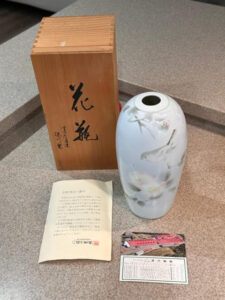 MA sent me a boxed Japanese Fukagawa porcelain vase with a lovely painting of a Warbler bird on a Cherry Blossom branch. The story goes back to 1616 in an area of Japan (Arita) which since then became known for the finest whites on the thinnest porcelain.
MA sent me a boxed Japanese Fukagawa porcelain vase with a lovely painting of a Warbler bird on a Cherry Blossom branch. The story goes back to 1616 in an area of Japan (Arita) which since then became known for the finest whites on the thinnest porcelain.
A Korean potter in 1616 discovered a slice of rock and minerals found in Arita contained a composition that made perfect porcelain.
The potter, eight generations ago, the first potter of the Fukagawa family, Ezaiemon, fired up the first family kiln in Arita in the mid-17th century (1650-1680). His kiln and factory became one of Japan’s first potteries for porcelain.
By the late 17th century he made tableware for the imperial Families of Japan and royalty in Europe noticed him. But of course, for generations Japan cut itself off from the trading world by choice. This gave Ezaiemon no easy way to export porcelain to Europe.
Fukagawa Growth in Popularity
The Dutch found a way around this embargo, and imported Arita ware. It grew in popularity in the high-class European houses. The late 18th and early 19th century porcelain objects made by Fukagawa are the most valuable.
Japan opened for business in the third quarter of the 19th century, which they call the Meiji period. For the west the opening of such a country with its artistic wonders caused a craze for anything Japanese. In France Monet collected Japanese woodcuts and so did Toulouse Lautrec. In England a new trend called the Aesthetic Movement begun after scholars and art dealers collected the new look of Japanese porcelain and art. The Aesthetic Movement imitated Japanese curving line, think pagoda roofs, and geometric patterns. English craftsmen began to make furniture with this flair. But no European or English porcelain achieved the purity of Arita ware.
By this time, 1875, the Arita porcelain factory owner gave his company a catchier name, the Company of the Scented Orchid, or Ko Ran Sha. Encouraged by the fervor for anything “Japanisme,” he designed a new company structure around export of the porcelain. Awards his company received at the best National Expositions (early World’s Fairs) also encouraged him. Ko ran sha won the 1876 Philadelphia Exposition, in 1878 and 79 they won in Paris and Barcelona. 1909, winner at the Alaska Yukon Pacific Exposition, winner in 1910 at the largest exposition known to Japan, the English-Japanese World’s Fair, then, a prize at the Panama Pacific in San Francisco in 1915, and grand prize in Industry at Liege 1930.
Family Rivalry
Of course, the family name passed to eight generations of potters but not without incident. In the late 19th century the SECOND son of the Fukagama potter who ran Ko Ran Sha had the nerve to start his own kiln and his own factory, Chuji Fukagawa. Then he won the biggest prize ever granted the family: the Medaille d’Or at the Paris International Exposition 1900.
This branch of the family business was given the charter to create porcelain for the Imperial Family from 1910 till today. Bloomberg lists the concern as still up and running in Arita. Amuseum Fukagawa shows what the Imperial Family eats from, and other Royal families’ tableware, and various vessels they have made, today designated Heritage of Industrial Modernization pieces. This branch of the family, Chuji Fukagawa, also has offices in Milan and Arita today.
But Ko Ran Sha is still going strong as well. It prides itself that although their 20th century style pieces have modern designs, the traditional ways of making porcelain are still in force. Even though they branched into porcelain electrical insulators for industry, they still retain the seven main older gentlemen, the artisans of Arita, who know all the secrets, and keep all the process, from clay to glazing, in house.
MA in Santa Barbara says he wants to sell this vase, along with the paperwork of authenticity, the softwood emblazoned box, dating from the mid-20th century, for $250. Anyone interested can email me at elizabethappraisals@gmail.com and I’ll put you in touch!
Pingback: Ceramic Umbrella Stand of the Aesthetic Movement - Elizabeth Appraisals